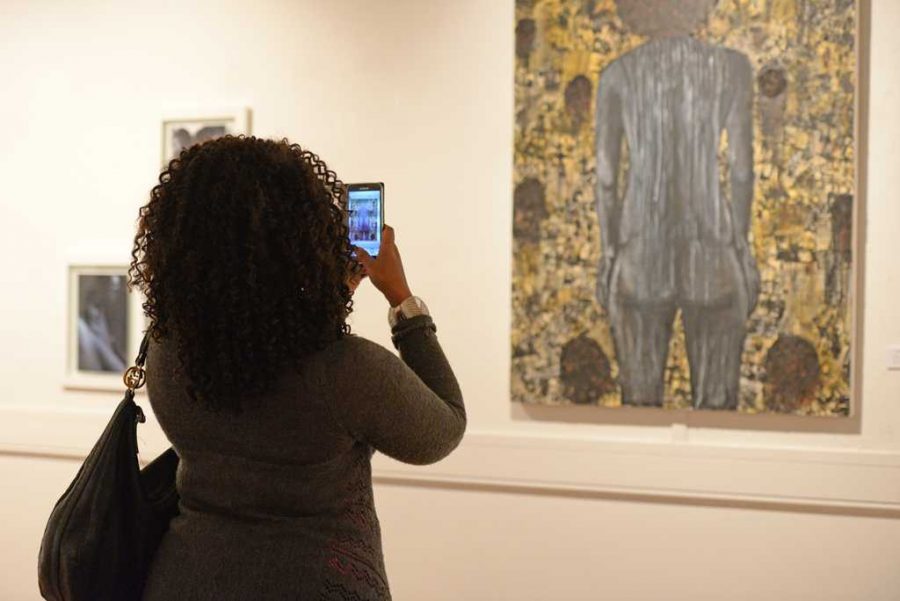
A reception guest takes a photo of one of the pieces of art in “Exposure: Black Voices in the Arts.” Meghan Sunners | Senior Staff Photographer
What a Pitt art exhibit was and was not sparked discussion Monday night, making space for the weighty absence of diversity in art galleries nationwide.
On Monday, Nov. 9, students from the Museum Studies Seminar hosted the opening of the mixed-media art exhibit titled “Exposure: Black Voices in the Arts” from 6:30 to 8:30 p.m. in the Frick Fine Arts building. The students orginally named the free exhibit “Exposure: Black Artists; White Bias,” but changed the title due to reservations from possible contributors.
The gallery, which showcases more than 40 artists from black, African-American and African diasporic origins who live in Pittsburgh, will run from Nov. 9, to Dec. 11, 10 a.m. to 4 p.m. The exhibit aims to draw attention to the lack of black voices in the art community.
“We hear about diversity a lot, but we don’t actually enact it,” Alexis Henry, a senior history of art and architecture, history and museum studies major, said. “We felt also that the University of Pittsburgh really needed [diversity], especially in the art scene, which is so diverse in Pittsburgh but often isn’t represented in a lot of museums.”
To emphasize the lack of black voices, the students came up with a title that did not hide their opinion of art culture.
“Exposure: Black Artists, White Bias,” according to professor Janet McCall, drew negative responses from some artists who felt the title was aggressive.
“Although the initial title was picked by the students, because they thought it made clear the gap that existed, we began to get feedback from some artists who said ‘I’d love to be in the show, but I’m a little concerned about the title,’” McCall said.
Exhibited artist Kee Adams from Fairywood in the West End said the name change presented a problem rather than solving one.
“The title was very important, because it’s the exact struggle we have, and it reflected that struggle,” Adams said. “So when I saw that it was changed I felt it was almost an act of pacifying for people that may have taken it in a way that they shouldn’t have.”
Open submissions for the show began in October for artists from all over Pittsburgh. Artists donated works to the gallery while the Braddock Library loaned art to the show from one of its Alternative Lending Collections. The exhibit includes quiltworks, sculptures and paintings that draw from the cultural and geographic background of the artist who created them. The artwork ranged from a sculpture depicting the Middle Passage, the forced journey Africans took from Africa to enslavement in America, to a multi-medium piece with lights, music and paintings.
Students in the seminar host a gallery event every semester as part of the main project for professor McCall’s course. McCall brought the idea of “absence” to the class, which prompted the students to think about the absence of black and African-American artists in many galleries and museums.
“The goal was really to bring awareness to the fact that there are not enough opportunities to exhibit and showcase work by African-American and black artists,” McCall said. “And to make the Pittsburgh community aware that we have some amazing, diverse art that’s being produced in Pittsburgh.”
Sophomore Caitrin Bogart, who is part of the seminar that organized the gallery, said the class hoped 1,000 people would show up on Monday night. As people strolled through Frick’s marbled doorway, Bogart said she thought the class might meet that goal, but she didn’t have an exact head count.
Students began working on this project at the beginning of the semester as part of their final portfolio for the class. The planning involved coordinating catering, arranging lighting and printing flyers to raise awareness for the event, Bogart said. Pitt and the History of Art and Architecture department funded the event.
Although Pitt provides money to cover the event, according to Bogart, students had to apply for an extra funding grant from the HAA department to cover extra costs like catering and tools for installation. The department granted the gallery $1,500, adding to the initial $3,000 endowment the Fine Foundation gave to HAA.
Grits Capone, a Guyanese artist showcased in the exhibit, drew influence for his photography from rioting in Baltimore following the death of Freddie Gray in 2014. He said the exhibit, as a whole, was about drawing attention to the talent that artists bring to Pittsburgh from across the globe.
“This exhibit is important because I feel like black people, African-Americans, people from the African diaspora, one of the things we contribute to the world is creativity,” Capone, who lives in the North Side of Pittsburgh, said.
Graduate student Natalie Sweet said the exhibit was a space purposefully limited to otherwise underrepresented members of the community.
“I think the work here fills a void that the University has, but I don’t think it’s 100 percent inclusive of every population,” Sweet said. “I don’t think it’s meant to be.”
Sophomore art history major Imani Williford said the gallery came at a vital time in United States history, but she said she would like to see black and African-American art find a place in the same revered galleries that white artists typically dominate.
“I think [the gallery] is important to have, obviously timewise, because of the Black Lives Matter and then recently the stuff that’s happening in Missouri, it’s timely,” Williford said, “but I think in a way, it shouldn’t have to be. In a perfect world I would just want African-American art to be next to a Picasso or next to a Van Gogh, not just reserved for a special moment in time.”

